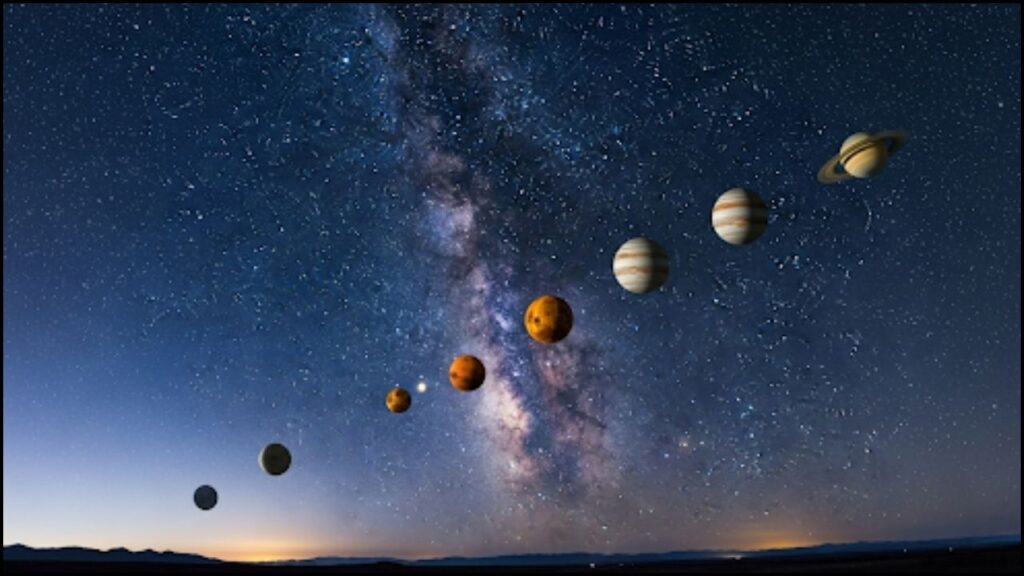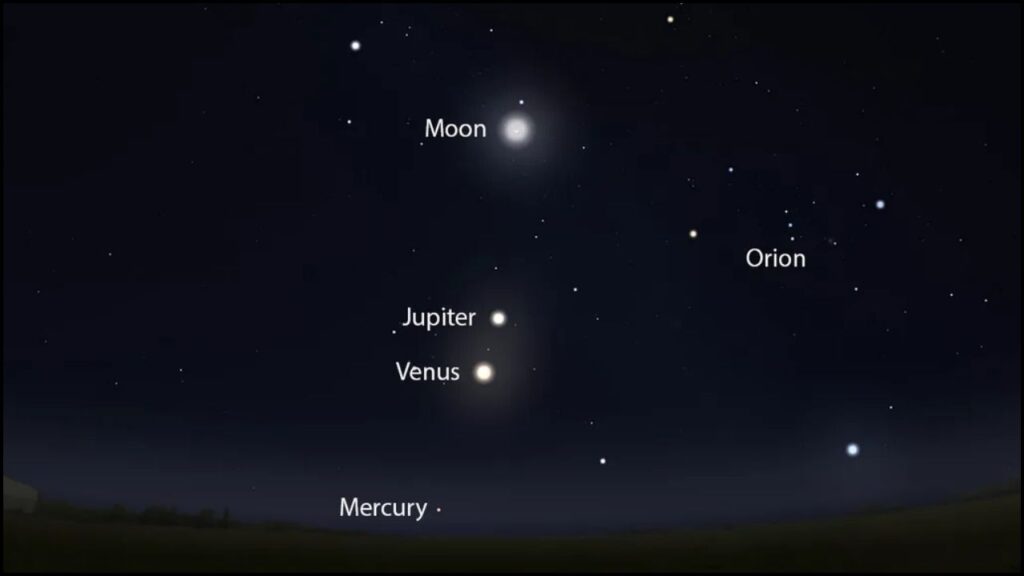Sky gazers are in for a rare treat this week as six planets Mercury, Mars, Jupiter, Saturn, Uranus, and Neptune appear to gather in the pre-dawn sky. This celestial gathering, often called a planetary parade, will be visible globally, offering a unique opportunity for both amateur and seasoned astronomers to observe multiple worlds in a single viewing session.

Key Details of the Celestial Event
| Key Fact | Detail |
| Planets Visible | Mercury, Mars, Jupiter, Saturn, Uranus, Neptune |
| Peak Viewing Window | Approximately 60-90 minutes before local sunrise |
| Direction | Low in the eastern sky |
| Equipment Needed | Naked eye for Jupiter, Mars, Saturn; Binoculars or telescope for Uranus & Neptune |
What to Expect from the Planetary Parade
In the final days of August 2025, six of the solar system’s eight planets will be observable in the same region of the night sky. The bright planets Jupiter, Mars, and Saturn will be the easiest to spot with the naked eye. Mercury will also be visible but will present a greater challenge due to its proximity to the rising sun.
“This is a wonderful opportunity to gain a real sense of the solar system’s layout,” said Dr. Michael Brown, a professor of planetary astronomy at the California Institute of Technology (Caltech). “You’re seeing multiple worlds, each in its own distant orbit, appearing to line up from our specific vantage point on Earth.”
The two outermost gas giants, Uranus and Neptune, will also be part of the procession, though they will not be visible without optical aid. A standard pair of binoculars will be sufficient to spot Uranus, while a small telescope is recommended to locate the fainter, more distant Neptune.

How and When to See the Alignment
The best time for stargazing will be in the brief window between when the planets have risen high enough above the horizon and before the dawn’s light washes them out. For most observers in the mid-northern and southern latitudes, this period will last from about 90 to 60 minutes before local sunrise.
To maximize your viewing experience, experts recommend the following steps:
- Find a Clear View: An unobstructed view of the eastern horizon is crucial, away from tall buildings or trees.
- Escape Light Pollution: Travel to a location with dark skies, far from city lights. According to the International Dark-Sky Association, light pollution can obscure all but the brightest celestial objects.
- Use a Stargazing App: Mobile applications can help locate the planets precisely. By pointing your phone to the sky, these apps use augmented reality to identify celestial bodies in real time.
“Patience is key,” noted a public outreach statement from the European Space Agency (ESA). “Allow your eyes at least 15 minutes to fully adapt to the darkness. The planets will be spread out across a significant arc, not clustered together in a tiny group.”
Understanding the Phenomenon
While the term planetary alignment is often used, it can be misleading. The planets will not be in a perfect physical line in space. Instead, they will be on the same side of the sun and will appear in a relatively small 95-degree sector of the sky from our perspective on Earth.
The Science of Orbital Mechanics
A true alignment, where planets form a straight line in three-dimensional space, is exceptionally rare. The current event is a visual grouping caused by the planets’ varying orbital speeds and paths around the sun.
“Think of it as runners on a circular track,” explained Dr. Brown of Caltech. “Occasionally, several runners will appear in the same section of the stadium from a spectator’s viewpoint, even though they are all in different lanes and moving at different speeds. That is what we are seeing with this planetary parade.” This line-of-sight effect is why astronomers prefer the term “apparition” or “grouping” to describe such events. It highlights the perspective-based nature of the celestial arrangement without implying a physical, straight-line configuration.
Future Celestial Events
While this six-planet gathering is notable, similar events occur every few years, though the specific combination of planets varies. The next major grouping of this scale is not expected for several more years, making this week’s event a significant viewing opportunity. Astronomical organizations are encouraging the public to take advantage of the spectacle. “Events like this don’t change anything on Earth, but they can change our perspective,” the ESA statement concluded. “Looking up at these distant worlds reminds us of our place in the vast and dynamic cosmos.”
How to Watch the Rare Venus Jupiter Conjunction Lighting Up the Pre-Dawn Sky
